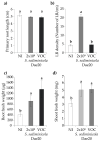Sphingomonas sediminicola Dae20 Is a Highly Promising Beneficial Bacteria for Crop Biostimulation Due to Its Positive Effects on Plant Growth and Development
- PMID: 37630621
- PMCID: PMC10459697
- DOI: 10.3390/microorganisms11082061
Sphingomonas sediminicola Dae20 Is a Highly Promising Beneficial Bacteria for Crop Biostimulation Due to Its Positive Effects on Plant Growth and Development
Abstract
Current agricultural practices rely heavily on synthetic fertilizers, which not only consume a lot of energy but also disrupt the ecological balance. The overuse of synthetic fertilizers has led to soil degradation. In a more sustainable approach, alternative methods based on biological interactions, such as plant growth-promoting bacteria (PGPRs), are being explored. PGPRs, which include both symbiotic and free-living bacteria, form mutualistic relationships with plants by enhancing nutrient availability, producing growth regulators, and regulating stress responses. This study investigated the potential of Sphingomonas sediminicola Dae20, an α-Proteobacteria species commonly found in the rhizosphere, as a beneficial PGPR. We observed that S. sediminicola Dae20 stimulated the root system and growth of three different plant species in the Brassicaceae family, including Arabidopsis thaliana, mustard, and rapeseed. The bacterium produced auxin, nitric oxide, siderophores and showed ACC deaminase activity. In addition to activating an auxin response in the plant, S. sediminicola Dae20 exhibited the ability to modulate other plant hormones, such as abscisic acid, jasmonic acid and salicylic acid, which are critical for plant development and defense responses. This study highlights the multifunctional properties of S. sediminicola Dae20 as a promising PGPR and underscores the importance of identifying effective and versatile beneficial bacteria to improve plant nutrition and promote sustainable agricultural practices.
Keywords: Brassicaceae plants; Sphingomonas sediminicola Dae20; growth promotion; plant growth-promoting bacteria (PGPR); root stimulation; sustainable agriculture.
Conflict of interest statement
The authors declare no conflict of interest.
Figures






Similar articles
-
Sphingomonas sediminicola Is an Endosymbiotic Bacterium Able to Induce the Formation of Root Nodules in Pea (Pisum sativum L.) and to Enhance Plant Biomass Production.Microorganisms. 2023 Jan 12;11(1):199. doi: 10.3390/microorganisms11010199. Microorganisms. 2023. PMID: 36677491 Free PMC article.
-
Optimizing Crop Production with Bacterial Inputs: Insights into Chemical Dialogue between Sphingomonas sediminicola and Pisum sativum.Microorganisms. 2023 Jul 21;11(7):1847. doi: 10.3390/microorganisms11071847. Microorganisms. 2023. PMID: 37513019 Free PMC article.
-
The Microphenotron: a novel method for screening plant growth-promoting rhizobacteria.PeerJ. 2022 May 13;10:e13438. doi: 10.7717/peerj.13438. eCollection 2022. PeerJ. 2022. PMID: 35586133 Free PMC article.
-
Use of plant growth promoting rhizobacteria (PGPRs) with multiple plant growth promoting traits in stress agriculture: Action mechanisms and future prospects.Ecotoxicol Environ Saf. 2018 Jul 30;156:225-246. doi: 10.1016/j.ecoenv.2018.03.013. Epub 2018 Mar 20. Ecotoxicol Environ Saf. 2018. PMID: 29554608 Review.
-
PGPR-mediated induction of systemic resistance and physiochemical alterations in plants against the pathogens: Current perspectives.J Basic Microbiol. 2020 Oct;60(10):828-861. doi: 10.1002/jobm.202000370. Epub 2020 Aug 19. J Basic Microbiol. 2020. PMID: 32815221 Review.
Cited by
-
Stenotrophomonas maltophilia promotes wheat growth by enhancing nutrient assimilation and rhizosphere microbiota modulation.Front Bioeng Biotechnol. 2025 Apr 17;13:1563670. doi: 10.3389/fbioe.2025.1563670. eCollection 2025. Front Bioeng Biotechnol. 2025. PMID: 40313642 Free PMC article.
-
Diversity of endophytic bacteria in mulberry (Morus spp.) scions with different genetic resources.Front Microbiol. 2025 Jun 24;16:1618773. doi: 10.3389/fmicb.2025.1618773. eCollection 2025. Front Microbiol. 2025. PMID: 40630189 Free PMC article.
-
Transient colonization by Priestia megaterium B1L5 alters the structure of the rhizosphere microbiome towards potential plant beneficial bacterial groups in apple plantlets.Environ Microbiome. 2025 Aug 13;20(1):104. doi: 10.1186/s40793-025-00762-x. Environ Microbiome. 2025. PMID: 40804700 Free PMC article.
-
Fumigant dazomet induces tobacco plant growth via changing the rhizosphere microbial community.Sci Rep. 2025 Feb 24;15(1):6673. doi: 10.1038/s41598-025-91432-y. Sci Rep. 2025. PMID: 39994419 Free PMC article.
-
Synergistic effects of yeast and plant growth-promoting bacteria on Tobacco growth and soil-borne disease suppression: evidence from pot and field experiments.Front Plant Sci. 2024 Nov 1;15:1489112. doi: 10.3389/fpls.2024.1489112. eCollection 2024. Front Plant Sci. 2024. PMID: 39554525 Free PMC article.
References
-
- Baweja P., Kumar S., Kumar G. Fertilizers and Pesticides: Their Impact on Soil Health and Environment. Soil Health. 2020:265–285. doi: 10.1007/978-3-030-44364-1_15. - DOI
-
- Backer R., Rokem J.S., Ilangumaran G., Lamont J., Praslickova D., Ricci E., Subramanian S., Smith D.L. Plant Growth-Promoting Rhizobacteria: Context, Mechanisms of Action, and Roadmap to Commercialization of Biostimulants for Sustainable Agriculture. Front. Plant Sci. 2018;9:1473. doi: 10.3389/fpls.2018.01473. - DOI - PMC - PubMed
-
- Shah A., Nazari M., Antar M., Msimbira L.A., Naamala J., Lyu D., Rabileh M., Zajonc J., Smith D.L. PGPR in Agriculture: A Sustainable Approach to Increasing Climate Change Resilience. Front. Sustain. Food Syst. 2021;5:667546. doi: 10.3389/fsufs.2021.667546. - DOI
-
- Hassan M.K., McInroy J.A., Kloepper J.W. The Interactions of Rhizodeposits with Plant Growth-Promoting Rhizobacteria in the Rhizosphere: A Review. Agriculture. 2019;9:142. doi: 10.3390/agriculture9070142. - DOI
Grants and funding
LinkOut - more resources
Full Text Sources
Molecular Biology Databases

